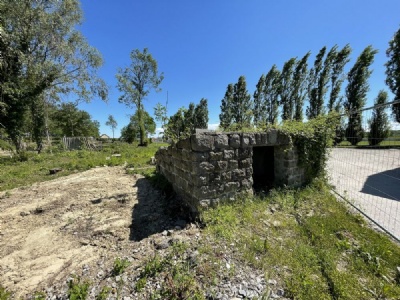Gusen I-III
In December 1939, prisoners from Mauthausen concentration camp set up a new camp next to a quarry in Gusen about five kilometers southwest of Mauthausen. As in Mauthausen, the main task of the prisoners was to work in the quarry. The camp’s first commandant was SS-Hauptsturmführer Karl Chmielewsky, who quickly gained a reputation as brutal. Among other things, he murdered prisoners unable to work by showering them with ice-cold water. In January 1941, a crematorium was built to cremate dead prisoners. Until then, dead prisoners had been cremated in Steyr. In January 1944, the construction of two large tunnel complexes, Kellerbau and Bergkristall, began in the vicinity of Gusen. The plan was to place war-produced industries in these tunnels and were finished in 1944. Prisoners used as slave workers in the tunnels were housed in a new camp called Gusen II (the first camp was consequently named Gusen I).
Gusen had until January 1944 been an independent camp but in connection with the establishment of Gusen II both camps became subordinated to Mauthausen. In December 1944, about three kilometers north of Gusen I and II, a third camp was set up in a small village called Lungitz. The camp was named Gusen III and prisoners were forced to work at a nearby quarry. Work in the tunnels and quarries was extremely dangerous and arduous and thousands of prisoners died as a result of the work. Both quarries and the war industries built in the mountains were owned by private and SS controlled companies and exploited the labor available in Gusen. All three camps were liberated by American troops May 5. About 71,000 prisoners from 27 different nationalities were imprisoned in Gusen and about half of them died. Gusen II and III were burned downed by the Americans because of typhus. Gusen I was gradually destroyed and looted by locals in the years following the war. In 1947, all tunnels were blown up after everything that could be reused had been removed.
Current status: Demolished with museum (2024).
Location: 48°15' 25.20" N 14°27' 50.32" E (Gusen I) 48°16' 05.89" N 14°26' 41.68" E (Gusen II) 48°17' 13.83" N 14°28' 27.74" E (Gusen III)
Get there: Car.
Follow up in books: Kogon, Eugen: The Theory and Practice of Hell: The German Concentration Camps and the System Behind Them (2006).





















Gusen was not the only camp that soon after the war was looted of everything that could be reused. For civilian population, it was more important to return to normal life as quickly as possible by building up their homes ravaged by the war. There were far-reaching plans to also demolish the remains of the crematorium at Gusen I to make room for houses and homes. But this was stopped thanks to former prisoners who bought the land in 1961 and gave it to the municipality in exchange for a monument (this was established in 1965). In 2003 a museum was opened at the site of the crematorium.
First time I visited Gusen was 2008, but only the crematoria, but when I returned in 2024 I also visited Gusen II and III. The crematoria memorial also has a small museum. At Gusen I former camp building still exists. The camp brothel (opened in 1942), a couple of prisoner barracks, SS barracks and Jourhaus (camp entrance). All buildings are privately own and belongs to companys or has become private homes, including the Jourhaus, which today is a lavish villa. When I returned to Gusen in 2024, archeological excavations was in process on the former SS ground and some barrack foundations had been uncovered.
In former camp area at Gusen II, houses and dwellings were built. But there are also several information boards and some kind of musem at the tunnel site. Despite most of the tunnels being destroyed or inaccesible a small part has been preserved for visitors, but can only be visited in accompany with a guide booked in advanced. The museum has no regular opening hours. At Gusen III there is a monument and next to it an ash pit with ashes from prisoners killed in the Mauthausen concentration camp system.